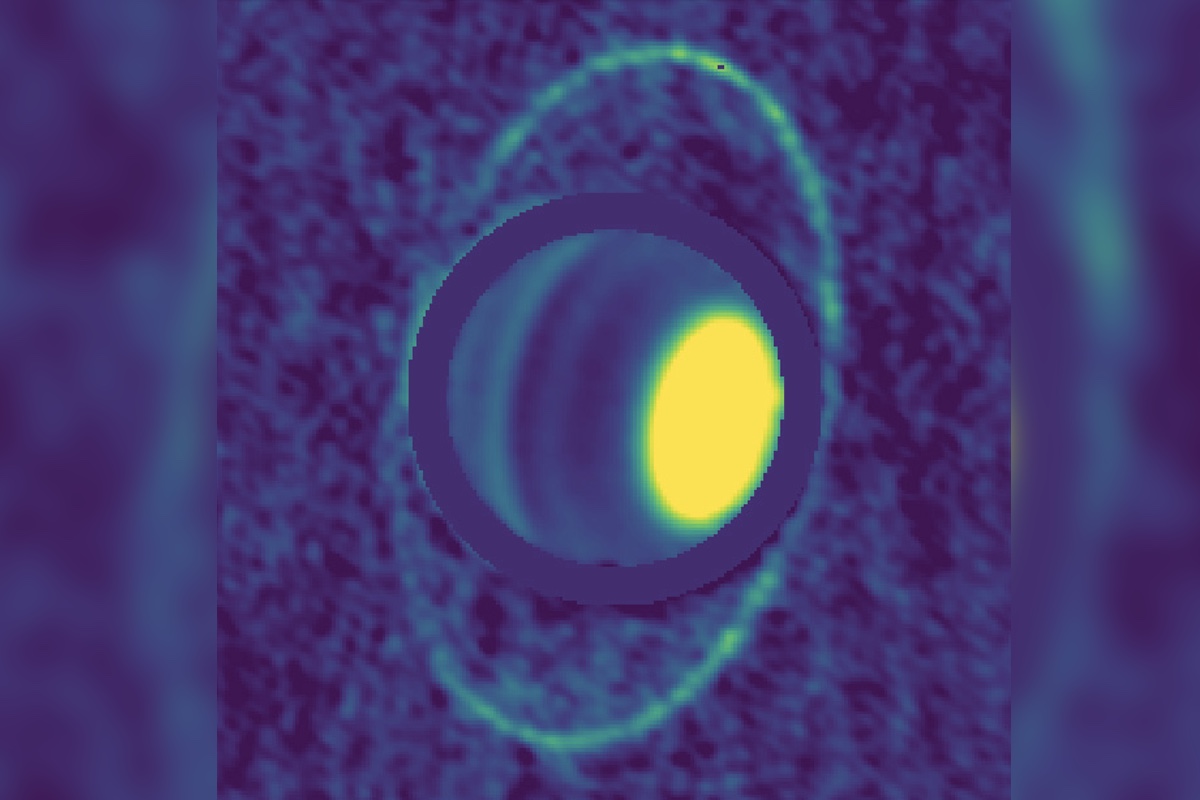Uranus Is a Weirdo — And So Are Its Rings

Uranus is a weirdo — the icy giant rotates while lying on its side and it's been called a rear end in even the highest echelons of academia (right?). Now, astronomers have found it has an oddball ring system, too.
In new images of the rings around Uranus (the seventh planet from the sun has 13 known rings), researchers have been able to decipher not only the temperature, but also the bits that create the rings.
The scientists found that the densest, brightest ring — called the epsilon ring — is pretty darn cold (by human standards): 77 Kelvin, which is just 77 degrees above absolute zero and the equivalent of minus 320 degrees Fahrenheit (minus 196 degrees Celsius). For comparison, the lowest temperature on Earth — minus 135 F (minus 93 C) — was recorded on an ice ridge in Eastern Antarctica. [Photos: The 8 Coldest Places on Earth]
Study researcher Imke de Pater, of UC Berkeley, told Live Science that she and her co-authors can't determine the temperature of the inner rings with the data they have so far.
For the study, the scientists looked at the rings through the Very Large Telescope in Chile, which detects visible wavelengths — the icy components of the rings reflect a teensy bit of light in the optical range — and the Atacama Large Millimeter/submillimeter Array (ALMA), also in Chile, which zooms in on wavelengths that straddle the radio/infrared part of the electromagnetic spectrum.
The results were glowing, as the icy particles inside each ring emitted a smidge of heat in the form of infrared radiation, to create a light-up composite image. From those images, the astronomers found that the epsilon ring has a wonky makeup compared with other planetary rings.
"Saturn's mainly icy rings are broad, bright and have a range of particle sizes, from micron-sized dust in the innermost D ring, to tens of meters in size in the main rings," de Pater said in a statement. "The small end is missing in the main rings of Uranus; the brightest ring, epsilon, is composed of golf ball-sized and larger rocks."
Get the world’s most fascinating discoveries delivered straight to your inbox.
In fact, Voyager 2 first spied this lack of itty-bitty particles when the craft photographed Uranus in 1986.
"It seems to me that the new images are confirming that big centimeter-sized objects (and larger) are likely the main constituent of the rings, which helps explain why they appear warmer than if it was lots of tiny dust particles," Leigh Fletcher, an astrophysicist at the University of Leicester, told Live Science in an email.
Indeed, the bone-chilling temperature of epsilon is a bit warmer than the researchers would have expected based on the amount of sunlight that hits objects at a Uranus distance.
"If these were tiny specks of dust, radiating away all the solar energy falling on them, then we'd expect them to be a few degrees cooler," Fletcher said. "But we can explain this warmth if we assume that the ring particles are slowly rotating and have a day-night contrast in temperature," with the side facing away from the sun being cooler until it rotates its face toward the sun again.
Fletcher added, "They're big enough that they don't have the same temperature everywhere, which means they're not re-radiating solar energy from their whole surface, and therefore can be a little warmer than expected."
The researchers said they hope that the new images will reveal more about not only the composition of the rings, but also whether or not they each came from different sources.
Planetary rings are made from the solar system's crumbs — whether from former asteroids getting sucked in by the planet's gravity, shards from moon collisions, or even the leftover scraps from the formation of the solar system 4.5 billion years ago.
- 11 Fascinating Facts About Our Milky Way Galaxy
- Spaced Out! 101 Astronomy Images That Will Blow Your Mind
- 15 Amazing Images of Stars
Originally published on Live Science.
Jeanna Bryner is managing editor of Scientific American. Previously she was editor in chief of Live Science and, prior to that, an editor at Scholastic's Science World magazine. Bryner has an English degree from Salisbury University, a master's degree in biogeochemistry and environmental sciences from the University of Maryland and a graduate science journalism degree from New York University. She has worked as a biologist in Florida, where she monitored wetlands and did field surveys for endangered species, including the gorgeous Florida Scrub Jay. She also received an ocean sciences journalism fellowship from the Woods Hole Oceanographic Institution. She is a firm believer that science is for everyone and that just about everything can be viewed through the lens of science.


